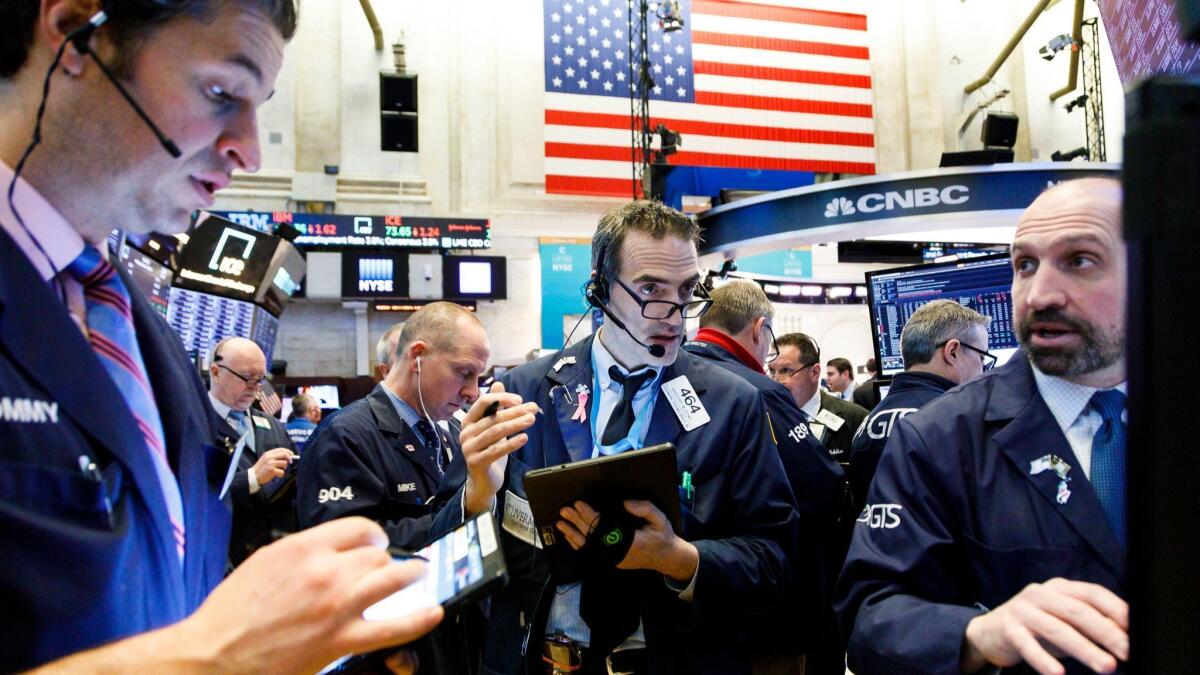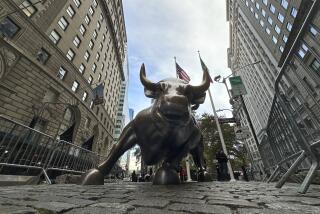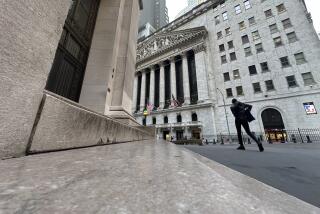Stocks slip again, capping their worst week of 2019

Another wave of selling on Wall Street on Friday left the Standard & Poor’s 500 index with its worst weekly showing since January and its eighth loss in the last nine days.
The sell-off, which lost some strength toward the end of the day, followed a surprisingly weak jobs report and more signs that the global economy is hitting the brakes. On Friday, a report showed that Chinese exports plunged 20% last month, far more than economists expected. On Thursday, Europe’s central bank said it was doing a policy reversal and restoring measures to shore up that region’s economy.
Energy stocks led the market’s slide as crude oil prices declined. Health-care companies and retailers also weighed on the market. Most homebuilders rose following a big jump in January housing starts.
The U.S. jobs report is the latest piece of discouraging economic news to give investors a reason to sell and pocket some of their recent gains as they wait for the next positive headline or economic data to pave the way for stocks to rise again, said Mark Watkins, regional investment strategist at U.S. Bank Wealth Management.
“We’ve had a very solid run, and there are investors who are going to be taking a little bit of money off the table,” Watkins said.
The S&P 500 fell 5.86 points, or 0.2%, to 2,743.07. The benchmark index has declined five days in a row, its longest losing streak in nearly four months.
The Dow Jones industrial average ended with a loss of 22.99 points, or 0.1%, at 25,450.24. Earlier in the day, it was down more than 220 points.
The Nasdaq composite fell 13.32 points, or 0.2%, to 7,408.14. The Russell 2000 index of smaller companies slipped 1.74 points, or 0.1%, to 1,521.88.
The market’s momentum has stalled this week after enjoying a sharp rebound at the start of this year. The S&P 500’s losses this week were its biggest since December but not as severe as they were then, when worries were peaking about a slowing global economy and that interest rates may rise too quickly. Since then, the Federal Reserve helped calm some of the worries by pledging to be patient in raising rates.
Still, investors are feeling increasingly uneasy about the global economy. The Organisation for Economic Co-operation and Development said this week that it expects global growth to be 3.3% this year, down from the 3.5% that it forecast four months ago.
The OECD said economic prospects are weaker in nearly all the countries that make up the G20 than previously expected, and it cited a slowdown in trade and global manufacturing, among other reasons. The United States and China have been locked in a particularly tense trade dispute, though the countries have said they’re making progress in negotiations.
Analysts are debating whether the U.S. stock market’s latest moves are the last gasps for the longest bull market on record for U.S. stocks, which began 10 years ago this weekend, or just the latest challenge for it to muddle through.
“Right now, the U.S. economy is gradually slowing, and earnings are trending a little bit lower,” Watkins said. “Any news that has been coming out that hasn’t been that strong has been a little bit of a negative catalyst for the market to have a reason to move back just a little bit.”
A slower global economy wouldn’t need as much oil, and the price of crude slid Friday along with expectations for demand. Benchmark U.S. crude fell 1% to $56.07 a barrel. Brent crude, the international standard, lost 0.8% to $65.74 a barrel.
The sharp decline sent energy companies down 2%, a decline twice as big as that of any of the other 10 sectors that make up the S&P 500.
Also hurting the sector was a decision by Norway’s $1-trillion wealth fund to dump shares of some oil and gas companies. The move would exclude companies that operate solely in exploration or production, but the fund will continue to own the biggest companies in the energy industry.
Noble Energy and EOG Resources tumbled 5.4%.
New U.S. residential construction data gave traders reason to be more optimistic about homebuilder stocks. The Commerce Department said housing starts jumped 18.6% in January as builders ramped up construction of single-family houses to the fastest pace in eight months. The rebound after December’s plunge bodes well for the new-home market heading into the spring home-buying season.
Hovnanian Enterprises shares climbed 4%. KB Home rose 1.5%.
National Beverage slumped 14.6% after the maker of La Croix soft drinks reported disappointing quarterly earnings. The CEO issued a puzzling statement, saying, “We are truly sorry for the results stated above,” and blamed the weak performance on unspecified “injustice.”
Costco Wholesale was the biggest gainer in the S&P 500, climbing 5.1%. The warehouse club operator reported profit growth that was far stronger than analysts expected.
Other retailers lost ground. Foot Locker fell 3.3%, Ross Stores slid 3.6%, and Gap declined 3%.
The weak U.S. jobs growth helped pull down the value of the dollar. The U.S. currency slipped to 111.07 yen from 111.52 yen. The weaker dollar sent the euro up to $1.1242 from $1.1186.
Bond prices were little changed. The yield on the 10-year Treasury note held at 2.63%.
Gold rose 1% to $1,299.30 an ounce. Silver climbed 2.1% to $15.35 an ounce. Copper fell 0.6% to $2.89 a pound.
Wholesale gasoline slipped 0.2% to $1.80 a gallon. Heating oil fell 0.6% to $2 a gallon. Natural gas held steady at $2.87 per 1,000 cubic feet.
More to Read
Inside the business of entertainment
The Wide Shot brings you news, analysis and insights on everything from streaming wars to production — and what it all means for the future.
You may occasionally receive promotional content from the Los Angeles Times.










